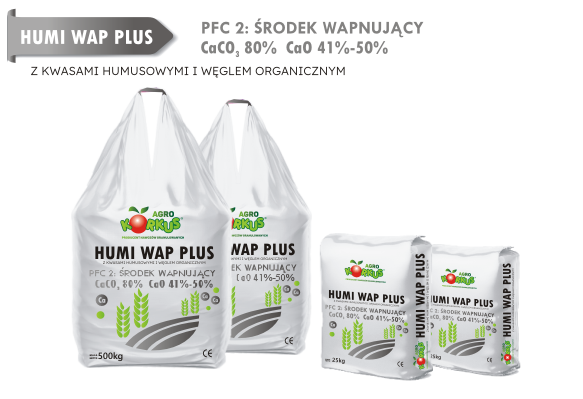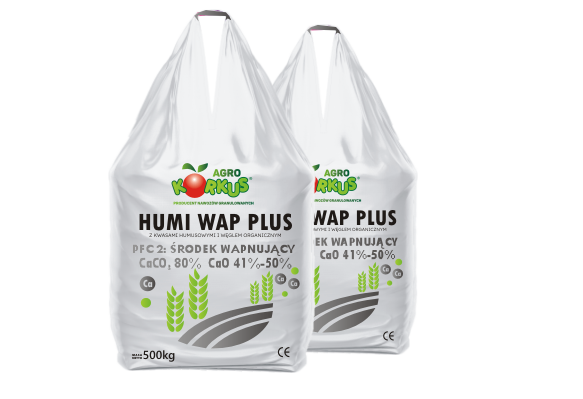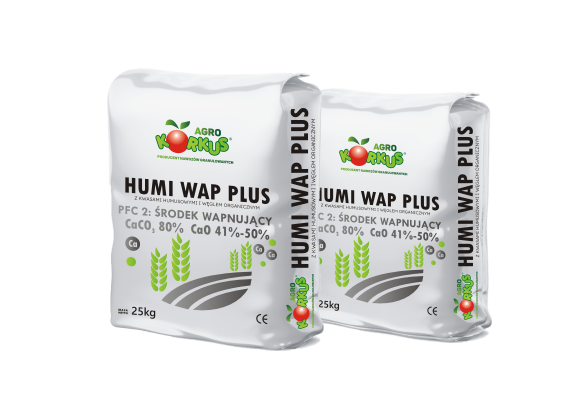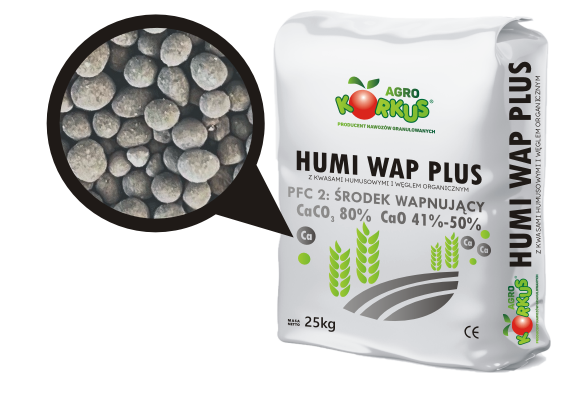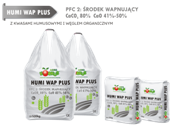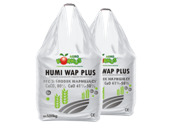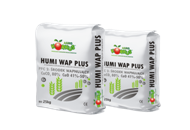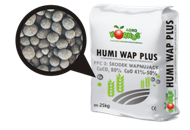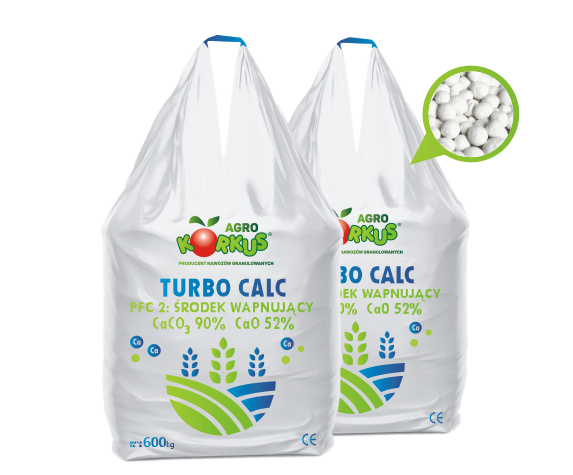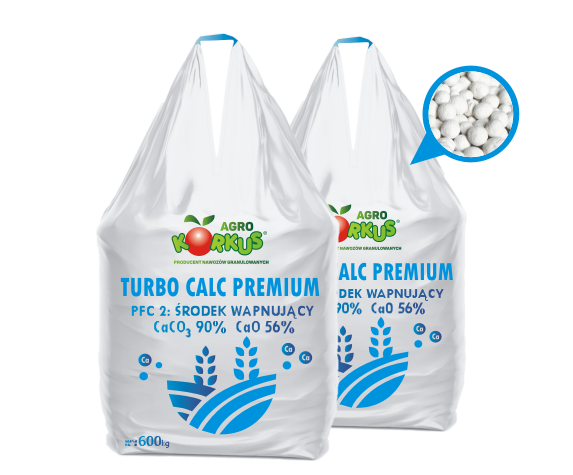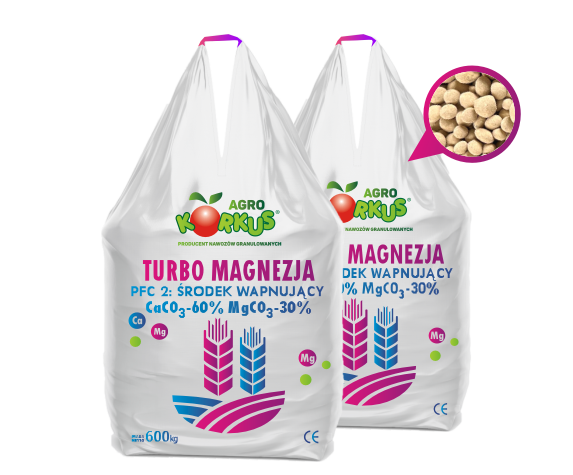Humi Wap Plus - highly reactive calcium fertiliser
HUMI WAP PLUS is a highly reactive liming material based on lake marl containing humic acids and the addition of organic carbon. Humi Wap Plus is an ecological and valuable fertiliser. It is used to deacidify the soil. For use in orchards, vegetable cultivation, agricultural crops or ornamental plants. It contains lake marl, calcite, soft calcium-carbonate, as well as organic components, including organic carbon and humic acids, fulvic acids and humin, as well as micro- and macroelements: magnesium, sodium, nitrogen, iron, potassium, sulphur, boron, phosphorus, manganese, zinc and copper.
HUMI WAP PLUS regulates the acidity of the soil and sanitizes it, eliminates pathogens: molds, fungi, putrefactive bacteria and other pathogenic microorganisms. It also reduces the occurrence of acidophilic weeds. It allows you to raise or maintain the right acidity level in the soil. This process contributes to the improvement and maintenance of the healthy development of root hairs responsible for nutrient uptake, as well as increasing resistance to lodging. Thanks to HUMI WAP PLUS, the soil improves its structure and the level of humus in the soil increases. As a result, the plants are well-nourished and strong, which makes them able to withstand droughts, frosts and vegetation stress. In addition, after regular application of fertiliser, plants absorb macronutrients from the substrate more efficiently. It results in better profitability and parameters of crops, as well as higher yields.
Humi Wap Plus is necessary to obtain high and good quality yields.
Declared nutrients:
Neutralisation number: 46
Granulometry: 90% (m/m) passes through a sieve with a mesh size of 1mm
Total calcium-oxide “quicklime” (CaO), % (m/m): 41,6% (Ca=29,7%)
Reactivity: 90%
Ingredients: calcium-magnesium carbonate (dolomite)1 CAS No. 16389-1,
limestone powder1, CAS No. 1317-65-3 where 1: CMC 1: Primary raw materials and mixtures
Additional information: Grain size: 91% fraction 2.0-6.0 mm.
Scope of usage
The fertiliser is intended to be used for field crops, gardening, orchard soils, grassland and after- crop, on all soils regardless of their mechanical composition. Good results are obtained while fertilizing meadows, pastures and permanent plantations. It deacidifies the soil improving its chemical and physical structure.
Dosage
The dose of the fertiliser should be well dosed each time depending on soil acidity,richness of soil and crops grown.
When applying fertiliser to plants, the dose of 500 kg CaO/ha should not be exceeded. Approximate doses of fertiliser in tons/ha, depend on the agronomic category and soil acidity are presented in the table. Advantages of using Turbo Calc fertiliser

The fertiliser can be applied from spring to late autumn before soil cultivation and/or top dressing fertiliser when crop growth conditions allow it. The fertiliser should be spread evenly over the surface of the field using available fertiliser spreaders or manually, each time in a way that excludes fertilisation of fields and crops not intended to be fertilised within this fertiliser. In case of pre-sowing application of the fertiliser it is recommended to mix it evenly with the soil to a depth of 20 cm.
How to storage fertiliser
The fertiliser should be stored in individual packages (big-bags), at most in two vertical layers. Precaution instructions for the storage and application of fertiliser. When used as intended the fertiliser does not pose a hazard. While working with fertiliser it is recommended to use eye protection, respiratory protection and protective gloves. In case of dust in eyes rinse them with plenty of clean water. Fertiliser can be harmful to humans and animals if ingested. In cases of alarming symptoms in humans or animals medical attention should be sought immediately.
Expiration date of the fertiliser
Unlimited validity providing that the correct conditions of its storage and disposal are preserved. Packaging of the fertiliser may change as a result of ageing (fading) and a long-term storage which does not affect the quality of the fertiliser.
Advantages of using fertilizer Humi Wap Plus
lowering the acidity of the soil
natural fertiliser
facilitating the access of water and air to the roots of plants
harmless usage
improves physical, chemical and biological properties
provides plants with aglime and rare
improves the quality of health and technological conditions of crops
organic and mineral fertilisation neutralises the harmful effects of heavy metals
technological conditions of crops
The composition of fertilizers, regardless of whether they contain oxide or carbonate lime, is always expressed in the amount of lime oxide, because it is required by the Act of July 10, 2007 on fertilizers and fertilization. It requires producers to provide information about the composition of fertilizers by specifying the calcium oxide content. Thanks to this, fertilizers can be compared and assessed, and it enables precise calculation of the dose of lime necessary to apply.


